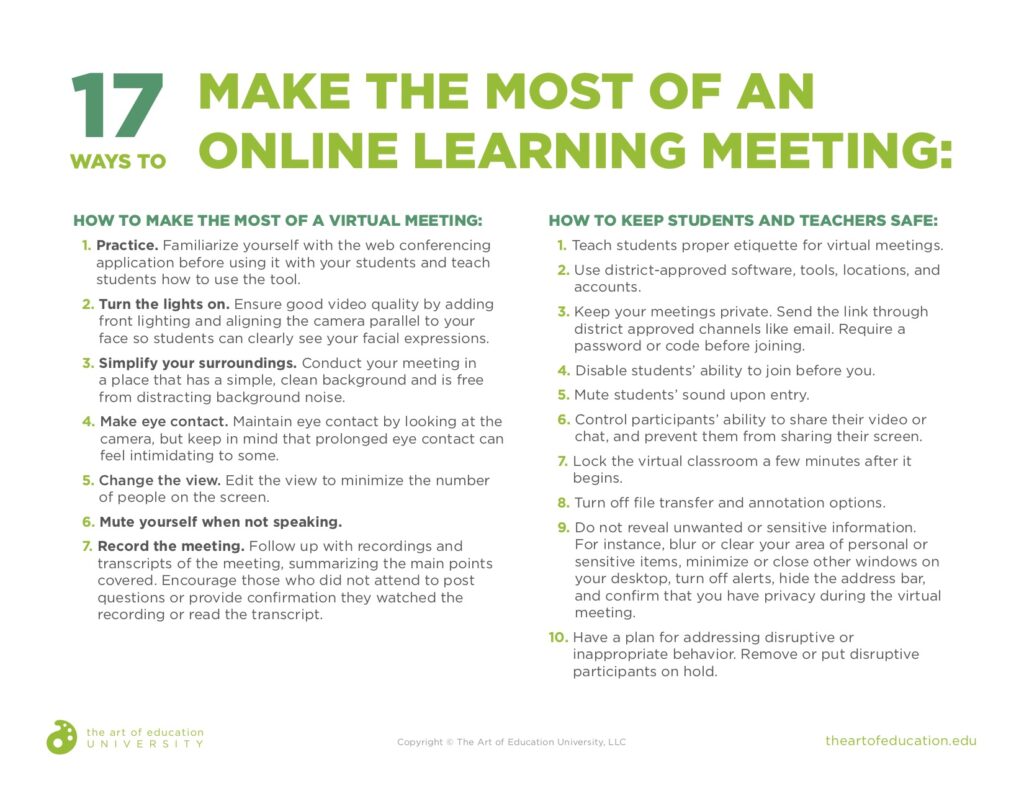Return to Learn with The Art of Education University
Relationships are the key to managing any classroom, but building those relationships while teaching online requires more creative effort than face-to-face situations.
Effectively using virtual meetings to deliver instruction, facilitate discussions, and collaborate requires preparation and consideration of communicative aspects, more so than in a face-to-face situation.
What is a virtual meeting?
Virtual meetings are synchronous. According to Natasha Gast, author of the article titled, “Introducing live group meetings in an online class: Tips and Techniques,” for a 2019 issue of Internet Learning, they are the closest you will get to a face-to-face learning environment while teaching online.
They happen in real-time, over the internet, using web conferencing software like Google Meet, Microsoft Teams, or Zoom. The integration of audio, video, text, whiteboards, and breakout rooms allow for direct instruction, immediate answers to questions, whole and small group problem-solving, and collaboration. In reality, “The versatility and accessibility of virtual meetings make them ideal for building relationships,” according to Wayne Journell and David Schouweiler, both scholars in online learning who, in 2020, wrote the article titled, “Moving K-12 Coursework Online: Considerations and Strategies.”
To make the most of virtual meetings consider these questions:
What is the purpose of the meeting?
Would a live demonstration, immediate feedback, and personal interactions deepen learning, clarify questions, and build community? Or could those goals be achieved as well asynchronously? Consider a class orientation. Making introductions, explaining course policies, and guiding students through the online platform could be delivered more effectively live since students get immediate answers to their questions and can associate faces with voices.
The experience becomes personal. Some other situations suitable for virtual meetings include office hours for individualized support, art critiques, and team building activities like scavenger hunts or games like Kahoot or Bamboozle.
How long should the meeting last?
If the decision is yours, consider the frequency in which you provide virtual meetings to avoid “Zoom fatigue.” Virtual meetings can be exhausting, especially when video and audio quality are poor. Students struggle to make sense of what is said without the clarifying nonverbal cues present in face-to-face situations or are distracted by the many faces and sounds happening at once.
Also, the length of time students can focus varies by age. Preschool students, for instance, are only able to focus for 25 to 30 minutes in live sessions.
Download this PDF to have a helpful resource with you at the ready.
What should you prepare?
Like any other new instructional strategy or tool, it is important to learn how to use it and teach your students how as well.
Remember these tips when planning a virtual meeting:
- Practice. Familiarize yourself with the web conferencing application before using it with your students and teach students how to use the tool.
- Turn the lights on. Ensure good video quality by adding front lighting and aligning the camera parallel to your face, so students can see your facial expressions.
- Simplify your surroundings. Conduct your meeting in a place that has a simple, clean background and is free from distracting background noise.
- Make eye contact. Maintain eye contact by looking at the camera, but keep in mind that prolonged eye contact can feel intimidating to some.
- Change the view. Edit the view to minimize the number of people on the screen.
- Mute yourself when not speaking.
- Record the meeting. Follow up with recordings and transcripts of the meeting, summarizing the main points. Encourage those who did not attend to post questions or provide confirmation they watched the recording or read the transcript.
How safe is it?
Just as if you were in the physical classroom, safety is critical. The same goes for the virtual classroom. The United States Cybersecurity and Infrastructure Security Agency (CISA) published recommendations in May 2020 for the use of video conferencing tools and platforms with students in grades K–12.
Follow these tips to keep students and teachers safe:
- Teach students proper etiquette for virtual meetings.
- Use district-approved software, tools, locations, and accounts.
- Keep your meetings private. Send the link through district approved channels like email. Require a password or code before joining.
- Disable students’ ability to join before you.
- Mute students’ sound upon entry.
- Control participants’ ability to share their video, chat with others, and prevent them from sharing their screen.
- Lock the virtual classroom a few minutes after it begins.
- Turn off file transfer and annotation options.
- Do not reveal unwanted or sensitive information. For instance, blur or clear your area of personal or sensitive items, minimize or close other windows on your desktop, turn off alerts, hide the address bar, and confirm that you have privacy during the virtual meeting.
- Have a plan for addressing disruptive or inappropriate behavior. Remove or put disruptive participants on hold.
Return to Learn with The Art of Education University
Will students want to attend?
Some aspects of distance learning are beyond your control, like equitable access to technology and high-speed internet. But, for situations where your students have that access, you can increase the likelihood they attend your virtual meetings by being empathetic to their situation, using clear communication, and providing extrinsic motivation.

According to Lynn Basko and Jillian Hartman, who wrote, “Increasing Student Engagement Through Paired Technologies,” for the Journal of Instructional Research, communicating when, how, and why participation is important increased attendance in virtual meetings. Schedule meetings ahead of time and post the dates, times, and meeting information in several places like the course calendar, updates or announcements sections, and emails. Sending a personal reminder or invitation through email or a text application like Remind.com, your students will be more likely to attend the virtual meeting.
Students or their families may be new to web conferencing or might have limited access due to poor internet quality. Schedule a meeting ahead of time with the student or parent to show them how to participate, even with limited access, and practice before the live event. Conduct the first meeting through email, phone, or a web conferencing application depending on the level of knowledge or needs of the participant.
Optional virtual meetings tend to have low attendance. It is not that students do not care; students may not want to bother you because they think they are doing okay. To increase attendance in your unmandated virtual meetings, provide incentives to pull them in.
Here are some incentives to try:
- Award bonus points.
- Invite a co-host or surprise guest.
- Hold a TikTok dance party.
- Provide time for show and tell.
- Highlight a student’s work.
- Set aside time for socializing.
- Mention students by name during the meeting to make them feel recognized and included.
How do students stay engaged?
Before you go live, practice using the virtual meeting platform to appear confident. Set time aside during that first meeting to teach students how to use the web conferencing application. Test the microphone, chatbox, and nonverbal feedback during an icebreaker activity.
Design the structure of your meeting to fit the audience and encourage them to be active participants. Plan to provide an opportunity for engagement every five minutes. Include a variety of teaching strategies like demonstrations, discussions, and hands-on activities. Use the whiteboard component to encourage collaboration or play games like Pictionary. Ask students questions, encourage them to share an example or provide a strategy, poll, or quiz them, and encourage collaboration. If you provide time for group work, limit the group size to three, and limit the time.
Final Thoughts
Web conferencing with applications like Google Meet, Microsoft Teams, and Zoom are here to stay. They make it possible for people to connect and share information regardless of the geographical distance. The use of those applications for holding virtual meetings increases students’ perception of teacher presence and their level of satisfaction with the course. Planning based on learning goals, district policies, and students’ needs along with a consideration of proper etiquette, and time to learn and practice using the tool, will ensure your virtual meeting is a success.
How do you plan to keep students engaged while learning online?
What are some of your go-to strategies for online learning?
Magazine articles and podcasts are opinions of professional education contributors and do not necessarily represent the position of the Art of Education University (AOEU) or its academic offerings. Contributors use terms in the way they are most often talked about in the scope of their educational experiences.





